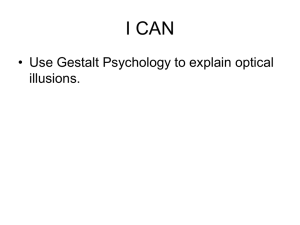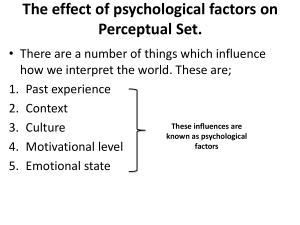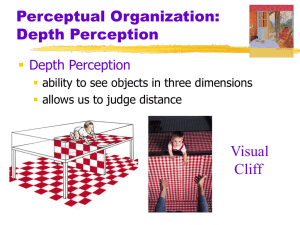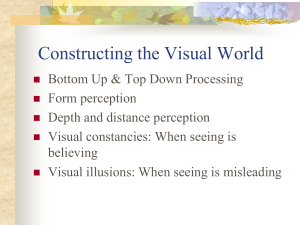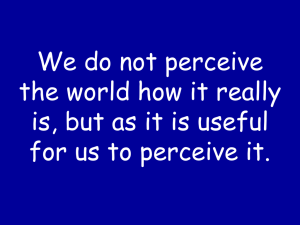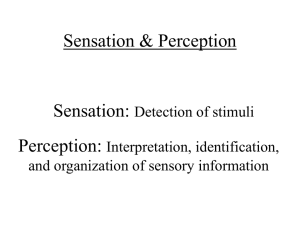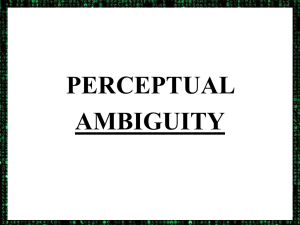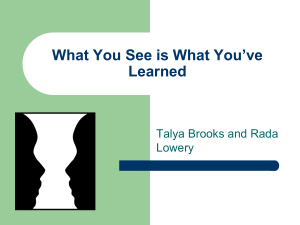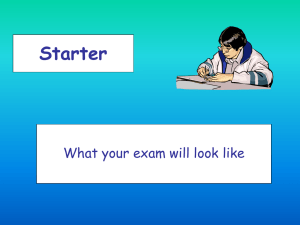1146854Perceptual organization 08JS
advertisement
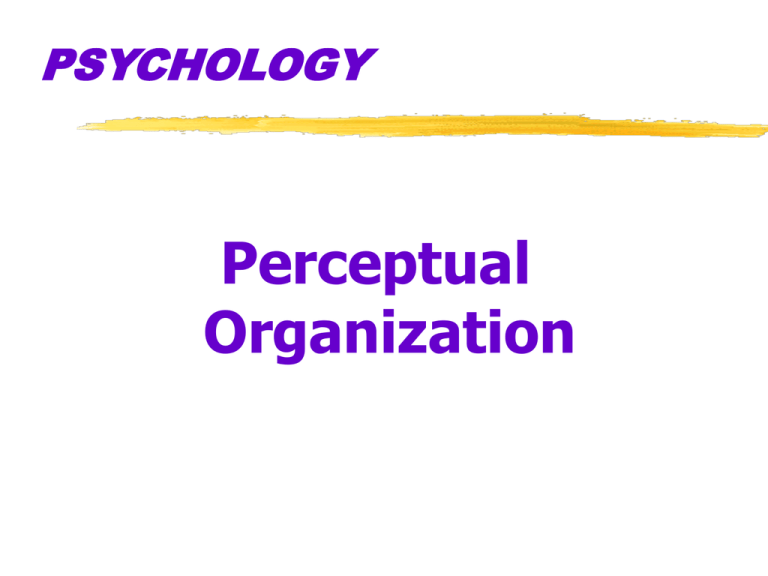
PSYCHOLOGY Perceptual Organization Perceptual Illusions http://www.yorku.ca/eye/m-lillu.htm Objectives 1. Understand how illusions help us understand perception 2. Understand perceptual organization principles Outline A. Intro & illusions B. Organizational Principles 1. Form perception Figure/Ground Gestalt grouping 2. Depth perception Binocular cues - retinal dispartity, convergence Monocular cues - 8 3. Motion Perception - stroboscopic, phi phenomemon 4. Perceptual Constancy - size & shape, size & distance, light, color Perception What can we learn from looking at the visual illusions #1-6 in your textbook? Illusion reveal the ways we normally organize and interpret sensation. Perceptual Illusions Perceptual Organization: Muller-Lyer Illusion Illusions Muller-Lyer Illusion We interpret the arrows as cues for distance & length The arrows at the ends of the lines make them appear of different lengths Room Illusion Room Illusion Perceptual Organization: Size-Distance Relationship Illusions What assumptions do we make about rooms? 90 degree angles Size & distance (we make the false assumption that they are the same distance way) To fool us they distorted the shape of the room St. Louis Arch Taller than wider? Wider than taller? Perceptual Organization: Depth Perception Relative Height St. Louis Arch Explanation: Relative Height - we perceive objects higher in our field of vision as farther away Perceptual Illusions Illusions Hans- Wallach’s - glowing blue worm Gestalt principles grouping principles lead you astray in this puzzle Apply grouping principles like - continuity Perceptual Illusions Illusions Hoffman - ripple illusion It is a shading technique using light & shadows Perceptual Illusions Illusions People tend to overestimate distance in the fog Light & Shadow issues Relative Clarity issues Where can this information be useful in the real world? Perceptual Illusions Perception What can we learn from looking at the visual illusions #1-6 in your textbook? Illusion reveal the ways we normally organize and interpret sensation. Which sense dominates? Visual Capture tendency for vision to dominate the other senses Ex. - movie theater, roller coaster Perceptual Organization: Gestalt Our brains do more then just register info, we filter & infer to make sense Gestalt = whole tendency to integrate pieces of information into meaningful wholes Necker Cube The whole may exceed the sum of the parts 8 circles - people tend not to notice the circles but the whole box Perceptual Organization: Illusory Contours Fig. 15.2 Is there really a line down the middle? Your eye perceives one Outline M15 A. Intro & illusions B. Organizational Principles 1.Form perception Figure/Ground Gestalt grouping 2.Depth perception Binocular cues - retinal dispartity, convergence Monocular cues - 8 3.Motion Perception - stroboscopic, phi phenomemon 4.Perceptual Constancy - size & shap, size & distance, light Form perception Our brains do more then just register info, we filter & infer to make sense by discriminating what it is - form We organize and interpret meaning QuickTime™ and a decompressor are needed to see this picture. What is it? Perceptual Organization Form perception Figure and Ground--organization of the visual field into objects (figures) that stand out from their surroundings (ground); Reversible figures What is it? QuickTime™ and a decompressor are needed to see this picture. What is it? QuickTime™ and a decompressor are needed to see this picture. Perceptual Organization: Gestalt Grouping the perceptual tendency to organize stimuli into coherent groups Gestalt grouping prin. Grouping Principles a) b) c) d) e) proximity--group nearby figures together similarity--group figures that are similar continuity--perceive continuous patterns closure--fill in gaps connectedness--spots, lines, and areas are seen as unit when connected PerceptualOrganization: Grouping Principles PerceptualOrganization: Closure Gestalt grouping principles are at work here. PerceptualOrganization: Grouping Principles Gestalt grouping principles are at work here PerceptualOrganization: Grouping Principles Impossible doghouse Perceptual Organization: Depth Perception ability to see objects in three dimensions allows us to judge distance Somewhat innate ability as shown by infants Perceptual Organization: Depth Perception Visual Cliff Depth perception 1. Binocular cues a) retinal disparity images from the two eyes differ closer the object, the larger the disparity (floating finger sausage) b) convergence neuromuscular cue - two eyes move inward for near objects 2. Monocular Cues a) relative size smaller image is more distant b) Interposition (overlay) closer objects blocks distant object Perceptual Organization: Depth Perception Relative Size Perceptual Organization: Depth Perception Interposition Monocular cues c) relative clarity hazy object seen as more distant d) texture coarse --> close fine --> distant Perceptual Illusions Monocular cues e) relative height higher objects seen as more distant Perceptual Organization: Depth Perception Relative Height Monocular cues f) relative motion closer objects seem to move faster g) linear perspective parallel lines converge with distance h) relative brightness closer objects appear brighter Perceptual Organization: Depth Perception Light and Shadow Perceptual Organization: Depth Perception Perspective Techniques Perceptual Organization: Depth Perception Illusory Depth Perceptual Organization: Depth Perception Illusory Depth Explanation Motion Perception 1. Stroboscopic movement - still pictures can be perceived as moving ( cartoons & film) 2. Phi phenomenon - 2 adjacent stationary lights blink on/off in succession are perceived as moving Perceptual Constancy Perceptual Constancy perceiving objects as unchanging even as illumination and retinal image change color shape size Size & distance p.239 Monster & Ponzo illusions Monster - linear perspective, relative height; cues to distance & size Ponzo - we perceive the bar as farther away as being larger based on experience Moon illusion Moon looks larger at the horizon then it does high in the sky Explanation: cues to objects distances at the horizon make the moon seem farther away Similar to the monster & ponzo illusion Perceptual OrganizationBrightness Contrast Perceptional Constancy 1. 2. 3. 4. Shape Size & distance Color Lightness/Brightness Concentrate on the 4 dots in the middle for 30 sec. QuickTime™ and a decompressor are needed to see this picture. Which is line is longer? QuickTime™ and a decompressor are needed to see this picture.

